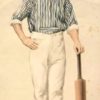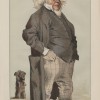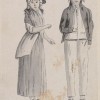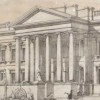
Jason Camlot, “The First Phonogramic Poem: Conceptions of Genre and Media Format, Circa 1888”
By 1888, the technology of the phonograph, and the medium of the phonograph cylinder, were established as market-ready. What was the imagined potential of this media technology in relation to known modes of communication and expression? This article recounts how “The Phonogram” or phonographic letter was prototyped from 1887 to 1892 through the efforts of Thomas Alva Edison and his London agent George Gouraud. Edison’s prototyping work and Gouraud’s efforts in developing recordings, scripts for phonogramic speeches, and formats for typographical transcription of the cylinder recordings represent a rich case study for documenting the nature and significance of their efforts to consolidate the medium and define the generic parameters of the phonogram (a speech recording) as a distinct form of global communication. By theorizing the relationship between late-Victorian concepts of medium, format and genre, respectively, and by interpreting the “first phonogramic poem” (16 June 1888) as an articulation of the meaning of sound recording at the historical moment that it arrived as a viable media technology, this article helps explain how sound recording technologies were imagined in relation to specific genres of communication. Drawing upon periodical literature, and documentation available through the Thomas Edison Papers archive—including phonogramic transcripts and speeches, marketing and foreign business strategies, patent applications, and packaging and design documents—this article explains, in particular, the generic and rhetorical protocols that informed the attempt to establish the phonogram as a new medium of intimate communication and international correspondence.

Joanne Wilkes, “The Implications of the Cricket Match in Anthony Trollope’s The Fixed Period (1882)”
Anthony Trollope’s late novel The Fixed Period (1882), set a century in the future in a fictional South Pacific island, has often puzzled readers. It deals with a policy of compulsory euthanasia in the politically independent island of Britannula, a policy that is overturned when the island is taken over by Britain. My article aims to explain an odd interlude in the novel: a cricket match in Britannula between a local and an English team. Drawing on the history of cricket matches between England and its antipodean colonies around the time of the novel’s composition, I argue that the cricketing interlude serves to highlight the text’s take on the Britannulans. This community, living a hundred years in the future, claims to be autonomous, but it possesses a mindset still governed by a sense of Britain as the “mother country.” Hence Trollope emphasizes how difficult it is for settler societies to shake off such attitudes and ties.

Peter H. Hoffenberg, “1871-1874: The South Kensington International Exhibitions”
The series of annual international exhibitions held during the early 1870s at South Kensington, London, were not particularly successful, or popular, but they were influential in the history of exhibitions. The alleged failures and the cancellation of the final annual exhibition halfway through the intended decade-long series of events provoked considerable discussion about the purpose, scale and expectations for exhibitions, which were no longer novel or limited to a particular city or nation-state. There were some successes, notably for the Australian colonies and British India, and for very specific trades and exhibitors, but the public discussion and those limited successes have generally failed to capture the attention of scholars. These events are rarely mentioned in books and articles about exhibitions and, when discussed, are considered to be failures without merit. This BRANCH contribution recognizes that other exhibitions were more popular and more successful, but also recognizes that the South Kensington shows were significant in addressing criticisms of exhibitions in general and in the generational history of both the shows and their organizers. The 1870s proved to be a pivotal period in the history of such exhibitions and the consideration of what merited public culture. The mantle was passed from Sir Henry Cole to his successors and the ambition of holding annual international exhibitions was replaced by more thematic shows in Britain and bold international shows in the Australian colonies. Amidst the general impressions of failure, there were also successes at the shows and those highlighted how inter-national exhibitions could prove useful in a changing world.

Ann Curthoys, “Settler Self-Government versus Aboriginal Rights, 1883 – 2001: The Shocking History of Section 70 of the Western Australian Constitution”
This essay describes the failed attempt by the British government to retain control over Aboriginal policy even while establishing self-government for the colony of Western Australia. The British made the attempt through a clause (Section 70) in the colony’s 1889 Constitution, which provided that £5000, or one per cent of the annual revenue of the colony when it exceeded £500,000, be set aside annually for the welfare of Aboriginal people. In addition, the British-appointed and controlled Governor, rather than the colonial government, would manage Aboriginal policy. The settlers hated the clause and in 1897 succeeded in persuading the British government to repeal it. Yet Section 70 was not forgotten, a legal challenge in the Australian High Court to its repeal failing as recently as 2001. The story of Section 70 provides a window for viewing the conflicts and collusions between imperial authorities and their settler colonies on questions of Aboriginal policy.

Julie M. Barst, “The Molesworth Report and the Dissolution of Convict Transportation to Australia, August 1838”
This entry focuses upon convict transportation to Australia (which spanned eight decades from 1788 to 1868) and argues that the Molesworth Report of 1838, which successfully built upon the rhetoric of the abolition movement by drawing connections between convicts and slaves, became one of the major deciding factors in eventually putting an end to the entire system of transportation. I claim that the report not only raised questions about the effectiveness of the system, but also generated sympathy for the convicts and led to a transformation in how Britons thought about the punishment of their criminal classes.

Jason R. Rudy, “On Literary Melbourne: Poetry in the Colony, ca. 1854”
Few in the mid-nineteenth century would have imagined the British colonies in Australia as spaces for poetic composition, and yet reproducing culture abroad was crucial to the British colonial project. This essay explores some of the challenges faced by poets in colonial Melbourne, a city at first more interested in gold digging than literary composition.
